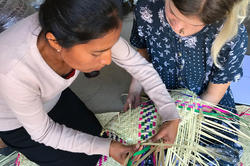Students in three Wintersession travel courses learn through hands-on work with local artisans in Mexico.
New-School Old World

When the RISD Global team was planning this summer’s travel courses, they worked with the Provost’s Office to pilot a virtual form of global engagement given pandemic-related travel restrictions. “Making the transition was challenging,” says Associate Director Valeria Albani, “since these classes are based on experiential learning and the influence of place on making.”
“Making the transition [to virtual] was challenging, since these classes are based on experiential learning and the influence of place on making.”
But participating students agree that the two virtual summer studios conducted this June—Denmark | Design Seminar & Workshop, taught by furniture designer Nathaniel (Ned) Smith and Italy | Form, Leather, Color & Craft, taught by shoemaker Anne Marika Verploegh Chassé—were sensational.

“We were immersed in the culture and traditions of Rome, met Italian designers and even learned to cook Italian cuisine,” says rising sophomore Jiahua Vivian Zhu 24 ID, who took the Italy class. “We heard from a huge variety of guest speakers—from shoemakers to filmmakers—and the experience was inspirational.”
“We heard from a huge variety of guest speakers—from shoemakers to filmmakers—and the experience was inspirational.”
Verploegh Chassé says that she designed the class to mimic the experience of travel, inviting students to tour the city, taste the food and visit local artisans, including celebrated designer Maria Sole Ferragamo. Each student also received a set of hand tools in the mail and a packet of leather from the Genuine Italian Vegetable-Tanned Leather Consortium in Florence. Verploegh Chassé also encouraged them to experiment with other, more accessible materials, such as paper and cardboard.

“The course was about experiencing materials in a different culture and using objects to tell stories,” she explains. “In my own practice, I collaborate with many different makers and work with all kinds of new materials, so I threw all of that into the course. It was awesome to see how the students reacted to that, fearlessly exploring and finding their own paths based on their skill sets and personal stories.”
“It was awesome to see how students reacted, fearlessly exploring and finding their own paths based on their skill sets and personal stories.”
Smith focused his Denmark class on the city of Copenhagen, virtually bringing the students along with him to visit design museums, studios of current designers and factories where Danish classics are built. “Design is integrated into the culture of Denmark and part of the daily life of every Dane,” he says. “And summers in Denmark are magical, so I really tried to convey that feeling and energy to the class.”

Graduate student Alice Cole MDes 22 picked up on that energy and hopes to channel the insights she gathered related to furniture and lighting design into her interior architecture practice. “I loved learning about an area of design different from my background and major at RISD,” she says. “It was really inspiring and made me think about my own design process from a different perspective.”

And Tzyy Yi Amy Young MFA 22 FD, who came into the class with a background in glass and ceramics and is currently studying furniture design, was also able to tap into the unique perspectives of Danish designers. “I’ve been familiar with Nordic design for a long time and have always loved its timeless simplicity,” she says, “but learning about Danish culture and history helped me to understand it more fully.”
One of the elements that grabbed her is the collaborative nature of civic life in Denmark, which begins in early education. “It’s not competitive there,” she explains. “The group works together. And that’s how Ned structured the class: everything we learned, we learned as a group.”

As she looks ahead to entering the furniture design industry, Young is thinking a lot about making scale models and designing for outsourced production. “We visited factories surrounding Copenhagen like Fritz Hansen and PP Møbler and talked about intentional design and the importance of considering not only form and aesthetics but also sustainability, function, cost and how the piece will be made,” she explains.
She still looks forward to visiting Copenhagen someday, and both of the faculty members who taught these virtual summer studios hope to offer in-person versions in future. “I learned so much from the experience and would love to do it again,” says Verploegh Chassé. “I have always been inspired by the forms, shapes, colors and smells of Italy. You carry those experiences with you as an artist.”
—Simone Solondz
July 30, 2021
